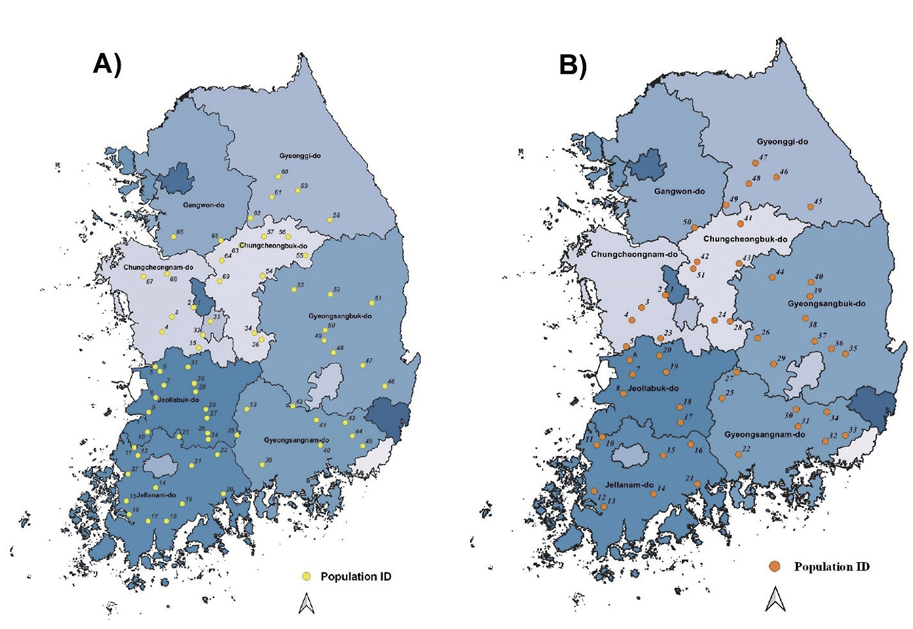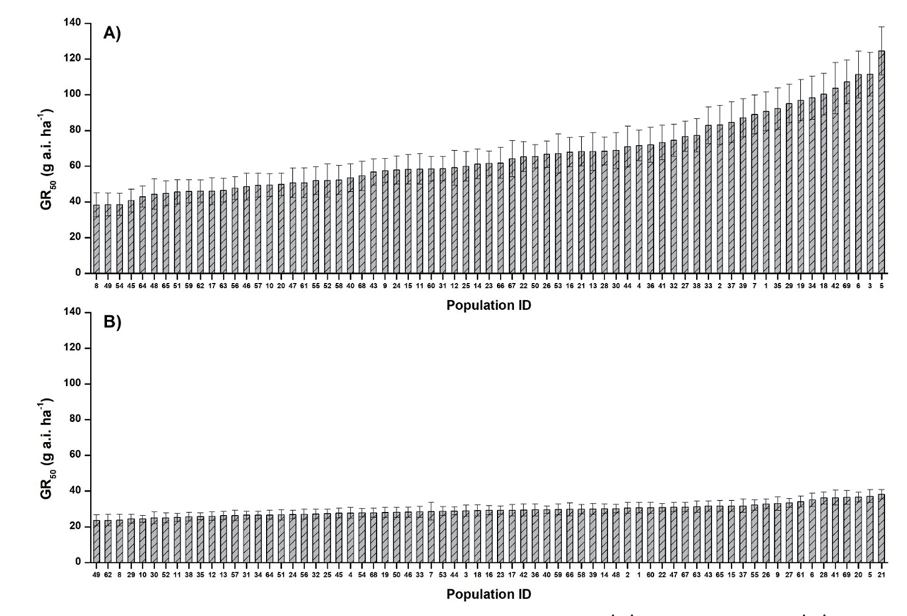Digitaria ciliaris is recognized as one of the most prevalent and competitive weed types in agricultural lands worldwide, and is also commonly found throughout Korea (Hwang et al., 2015; Jones et al., 2021; Umurzokov et al., 2023). Its invasive nature poses a significant threat to crop yields, and it is particularly challenging to manage due to its ability to reproduce rapidly and withstand adverse environmental conditions. As such, it is crucial for farmers and researchers to understand the biology, physiology, and ecology of this species to develop effective management strategies and safeguard agricultural productivity.
Cyperus spp., an exogenous plant, possesses biological and reproductive traits that afford it an advantage over other plants. It has been identified as the world's most noxious weed, based on the number of countries where it has been reported as a serious, principal, or common weed (Bendixen and Nandihalli, 1987; Bryson and Carter, 2008). Cyperus esculentus L., belonging to Cyperus spp. has been recorded for the first time in agricultural field in Icheon of Gyounggi province in Korea (Lee et al., 2011). It is essential to understand the response of Cyperus spp. to chemical herbicides since it is found in the agricultural field.
D. ciliaris and Cyperus spp. is predominantly found in horticultural fields and are managed through the application of chemical herbicides. Nevertheless, repeated use of the same herbicide or those targeting the same site could result in herbicide-resistant weed populations. Baseline sensitivity, which is the initial point for determining any weed's sensitivity to a particular chemical compound, can be utilized to establish herbicide resistance thresholds for any herbicide (Espeby et al., 2011). A fundamental aspect of developing effective and sustainable strategies for weed management is gaining a thorough comprehension of the inherent sensitivity of weed populations to herbicides. This knowledge is critical for devising targeted approaches that can minimize the potential for herbicide resistance and promote the use of environmentally friendly practices (Park et al., 2022; Umurzokov et al., 2023). Baseline sensitivity serves as a basis for optimizing herbicide applications, reducing environmental impacts, and preventing herbicide resistance in weed populations. Therefore, this study aims to investigate the baseline sensitivity of D. ciliaris and Cyperus spp. populations to s-metolachlor and alachlor herbicides in horticulture fields in Korea.
Weed species (D. ciliaris and Cyperus spp.) were collected in horticulture fields from August to October 2022. Monitoring was conducted at 69 sites for D. ciliaris (Fig. 1A) and 51 sites for Cyperus spp. (Fig. 1B) in all provinces of Korea. The whole plant doseresponse experiment was conducted in an experimental greenhouse. After testing the germination of each biotype, 3-5 seeds of each biotype were sown in a perforated tray (60 cm x 40 cm x 15 cm) filled with topsoil (Seoul Bio Co., Ltd. Chungcheongbuk-do, South Korea) and kept in greenhouse. Three days after sowing, s-metolachlor (25% EC; BattaejangTM, Hankooksamgong Co., Ltd. Seoul, South Korea) and alachlor (43.7% EC; RassoTM, FarmHannong Co., Ltd. Seoul, South Korea) were applied at 11.7, 23.4, 46.8, 93.6, 187.5, 375, 750 (standard dosage) g a.i. ha-1 and 13.7, 27.4, 54.6, 109.3, 218.5, 437, 874 (standard dosage) g a.i. ha-1, respectively. The above-ground fresh weight of the treated weeds was measured 21 days after treatment (DAT).Plant datasets obtained in dose-response studies were analyzed by fitting a log-logistic model to estimate treated weeds' GR50 values. The data were expressed as the percentages of untreated control estimates. A non-linear regression dose-response equation (Streibig, 1980) was used in the OriginPro 8.1 (OriginLab, 2021) program.
where y is fresh weight, x is the dose of herbicides, a is the minimum value, d is the maximum value, c is GR50, and b is proportional to the slopes around the dose of GR50.BSI was calculated by dividing the greatest GR50 value (GR50max) by the smallest GR50 value (GR50min).
One-way ANOVA statistical analysis was performed using OriginPro 8.1 (OriginLab, 2021).
In the whole plant dose-response test, a greater reduction in growth of 85-100% was observed in D. ciliaris after applications of s-metolachlor at the dose of 750 (standard dosage), 375, 187.5 g a.i. ha-1, and the application of alachlor at 874 (standard dosage), 437, 218.5, and 54.62 g a.i. ha-1. To compare the differences in sensitivity of weed biotypes to herbicides, the GR50 values of D. ciliaris were ordered from the lowest to the highest value for s-metolachlor and alachlor (Fig. 2). In this study, the GR50 values of D. ciliaris ranged from 38.3 to 124.6 g a.i. ha-1 in s-metolachlor and 23.6 to 38.2 g a.i. ha-1 in alachlor, resulting in a BSI of 3.25 for s-metolachlor and 1.61 for alachlor (Table 1).
In the whole plant dose-response test, a greater reduction in growth of 85-100% was observed in Cyperus spp. after applications of s-metolachlor at the dose of 750 (standard dosage) and 375 g a.i. ha-1, and the application of alachlor at 874 (standard dosage) and 437 g a.i. ha-1. To compare the differences in sensitivity of weed biotypes to herbicides, the GR50 values of Cyperus spp. were ordered from the lowest to the highest value for s-metolachlor and alachlor (Fig. 3). The GR50 value in Cyperus spp. ranged from 41.9 to 98.4 g a.i. ha-1 for s-metolachlor and 25.2 to 33.7 g a.i. ha-1 for alachlor, resulting in a BSI of 2.34 for s-metolachlor and 1.33 for alachlor (Table 1).
Table 1
Baseline sensitivity indices of Digitaria ciliaris and Cyperus spp. populations to s-metolachlor and alachlor in Korea in 2022. Values are the mean of three replications (n=3) followed by the standard error (±SE) of the mean. The GR50 value is the dose requiring a 50% reduction in fresh weight. D

Based on the BSI results, we estimated that the potential risk of herbicide resistance development in populations of D. ciliaris and Cyperus spp. to the herbicides s-metolachlor and alachlor in Korea would not occur in the short term. Although the number of populations we tested in this study is not sufficient to represent all populations in Korea, we visited and collected weed seeds from the major horticulture fields in Korea. Overall, the results of this study are expected to provide valuable data for developing sustainable strategies for crop cultivation with respect to herbicide use in Korea.





